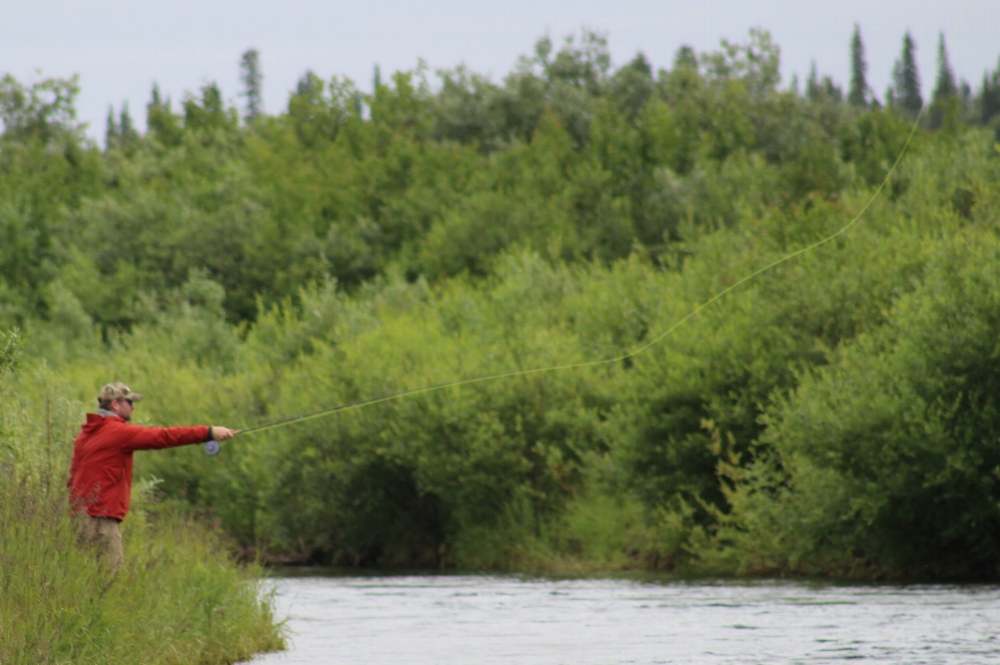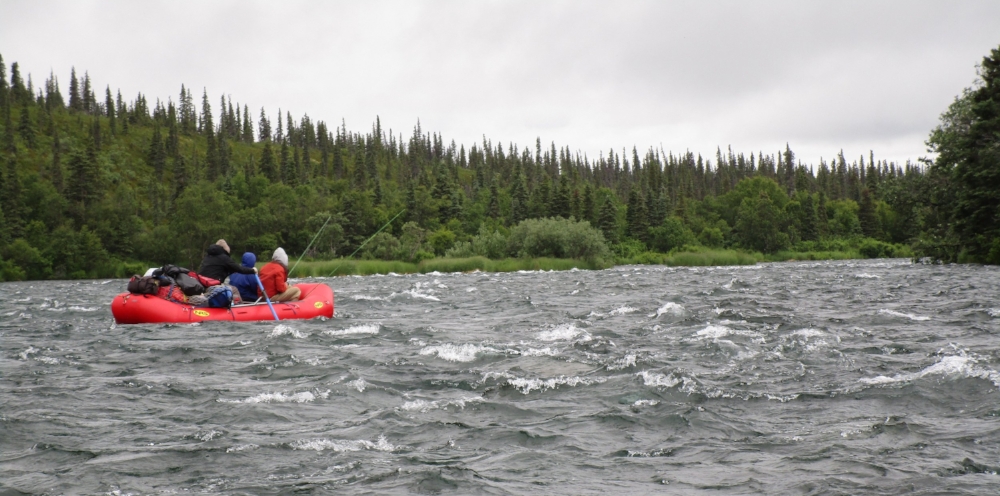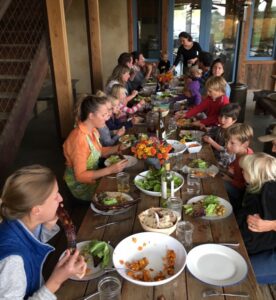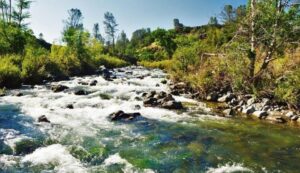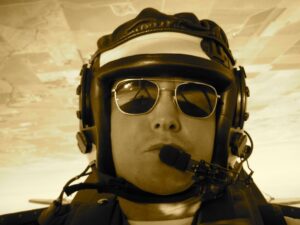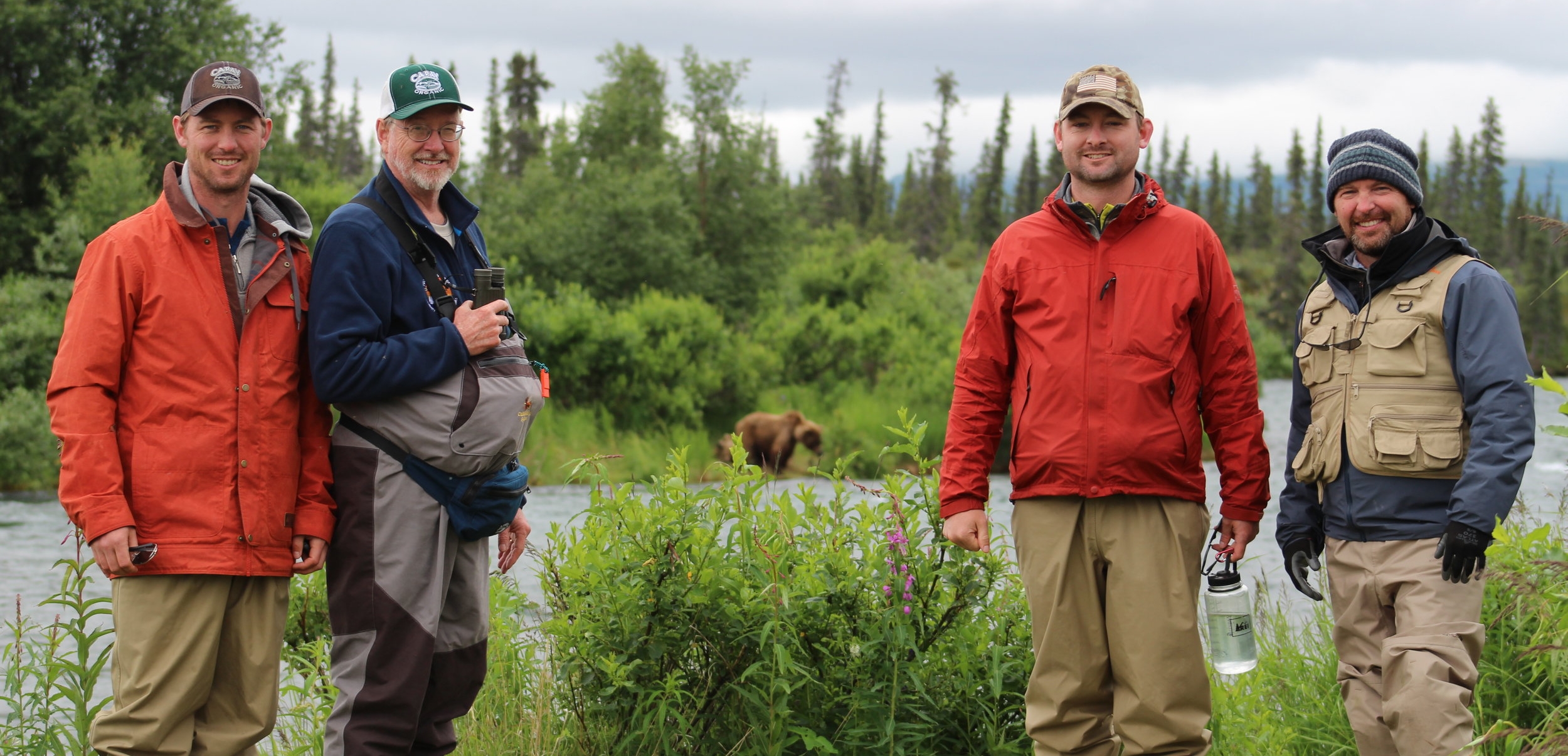
From the lobby of a small airfield we watch the World Cup, France and Croatia are tied 1-1 as we depart Anchorage in a ten-passenger plane on our way out ‘there,’ none of us are sure where exactly we are going. In the context of life on the grid with work and a young family I am pleased with myself for arriving on time with all my gear. Knowing where we were headed was a level of prepared I was not, for this trip I was along for the ride. For months the second week of July had been fast approaching and on my outlook calendar, it stuck out as an inconvenience to my normal schedule. I knew it would be fun once we got there, seven days floating and fishing in the Alaska bush with my brothers and Uncle are what life long memories are made of. With Anchorage still in sight I take a quick video and text it to my wife, once the message is delivered I turn off my phone, half anxious, half excited, that I will not touch it for seven days. From the plane I see snowcapped mountains in front of us, the pilot turns to the right to avoid them as he navigates through a pass. We are at eye level with glaciers, one after another. Arriving at Iliamna we all look at each other with huge smiles. “That flight did not disappoint!” Noah comments.

We are shuttled from the airport to our jumping off point. Arriving at the beach of a small lake we meet our two guides and are asked to put on our waders and pack our gear into water tight bags. All our hours awake for the next week would be in these waders. With the gear lined up our two guides load into a Beaver, a small float plane equipped with a roaring 450 horse power engine, with half the gear they disappear. I am amazed that the plane flies, its take off is anything but graceful, brute strength wills it into the air – like watching a turkey fly. It is our turn. My two brothers, Noah and Freeman, our Uncle Brian and I load in, the machine motors to the far side of the lake like a tall boat, the throttle is pushed forward, we motor along the surface of the lake in a slight arch, then miraculously transform into an airplane. Half an hour later we land and motor to the shores of Nonvianuk Lake where our guides have inflated two red rafts and have camp set up. It is sunny, there is a strange buzz that fills the air, it sounds like a million tiny little weed whackers running – insects. With the plane gone there are six of us, two rafts, a vast wilderness and a lake feeding a flowing river that will guide us to where the plane will pick us up.
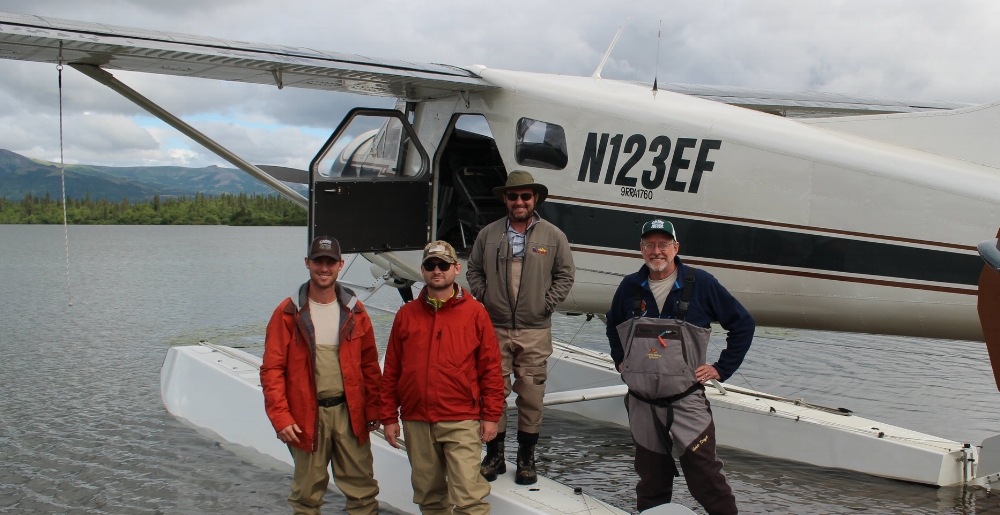
Coffee is waiting for us when we wake up in the morning. We are all excited to catch some fish, we can see the sockeye rolling in the lake as they continue their journey upstream to a tributary where they will spawn then die. The guides hand us fly fishing rods rigged up for sockeye and give us a crash course on fly fishing. It is not pretty, none of us know how to fly fish. After some embarrassment and one broken rod we begin catching sockeye. Uncle Brian is the first, with excitement he exclaims “It can be done!” They give an amazing fight, sometimes they leap from the water into the air flashing like a piece of aluminum foil in the sun. As they run the sound of the drag on the fly feel makes a long and satisfying zinging sound. After landing two sockeye, back-to-back, my arm is tired from reeling in five plus pound fighting flesh. We release all of them, with no way to freeze the salmon we will only keep what we will eat. With the morning fishing done our camp is packed onto the rafts. Three people in each raft, two of us in the front and a guide behind us, using the oars to position the raft as it flows downstream.
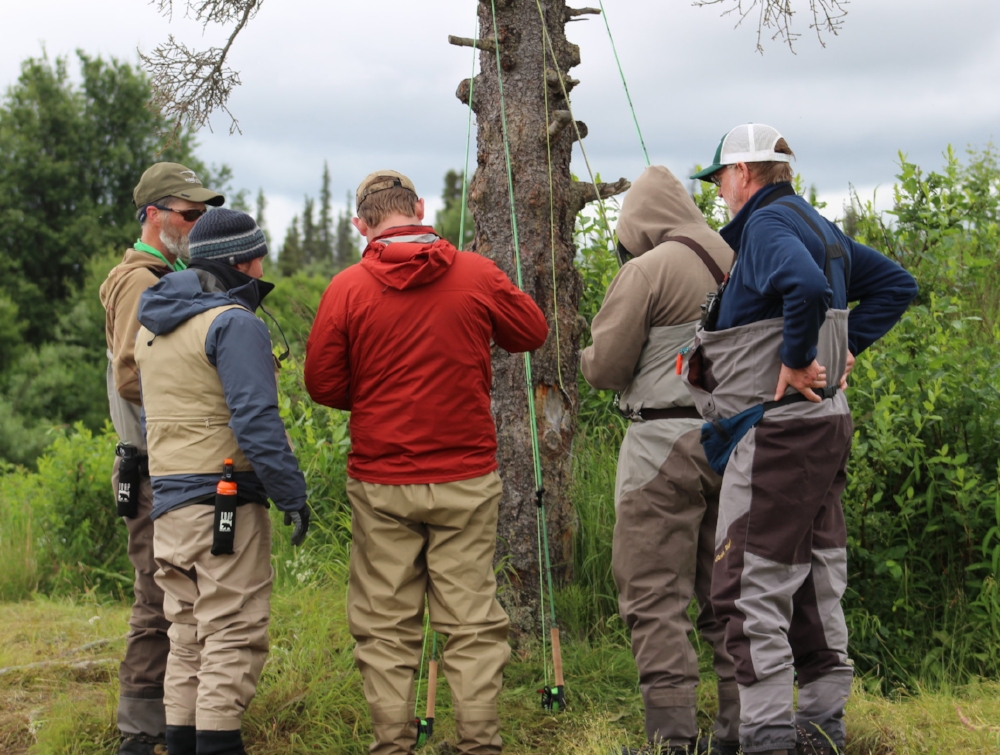

Sitting on the bank of the water is a mother grizzly bear with three adorable cubs. Mom is sitting looking into the water, her head nodding back and forth as she scans for sockeye. The cubs sit patiently but we can tell they are bored. Mom splashes into the water after a salmon, a miss, she shakes herself off. The guides start rowing quickly and tell us camp is here, we think it is a joke, but it is not. Camp is where the Nonvianuk River and the Kukaklek River join to make the Alagnak River, they call this spot ‘The Fork.’ By now we have figured out we are in the Katmai National Park and Preserve and that this water is destine for Bristol Bay. From our camp we watch momma bear, who is not the only bear fishing on the river. A huge male grizzly arrives, he stands on his hind legs to look at us but finds his fishing more interesting. Two teenage bears swim across the river. A larger male bear plops himself into the river and dunks most of his head, but not his ears, into the water and looks for fish. We nickname him ‘The Snorkeler,’ his strategy pays off quickly, with a fish flopping from his mouth he walks out of the river to eat it, he is back in five minutes. We are in the heart of bear country, grizzlies from this part of the Aleutian Range are here to take advantage of their most valuable food source for the year. Humbled by not being at the top of the food chain we become very interested in how to use the bear spray and I wonder what type of wilderness guides in Alaska do not pack guns, apparently the type with us.

While floating to the next camp we see a bear in the middle of the river, our guide brings our raft close to him and I notice this bear is not fat like the others, he is skinny and stares us down – I feel like prey. As we pass within fifteen yards he takes a couple quick steps towards us, closing the distance that separates us. For a moment the bear and I share the same thought – can a bear jump into a raft to grab a human? Paralyzed with fear my mind further develops that thought and realizes that this is what happens right before you get eaten by a bear. The bear stops short and stares us down as we float downstream. A fat bear is a safe bear, a skinny bear is a desperate bear who, if determined to eat you, likely would not be deterred by bear spray. Alive with the bear upstream, I chuckle to recall a conversation the guides had told us about an old-timer. The old timer asks, “What kind of bear spray do you have, round or square can?” The guide replies, “The square kind, why do you ask?” The Old-Timer fires back, “The round can is better because it will not hurt as much when the bear shoves it up your ass.” We have the round kind.
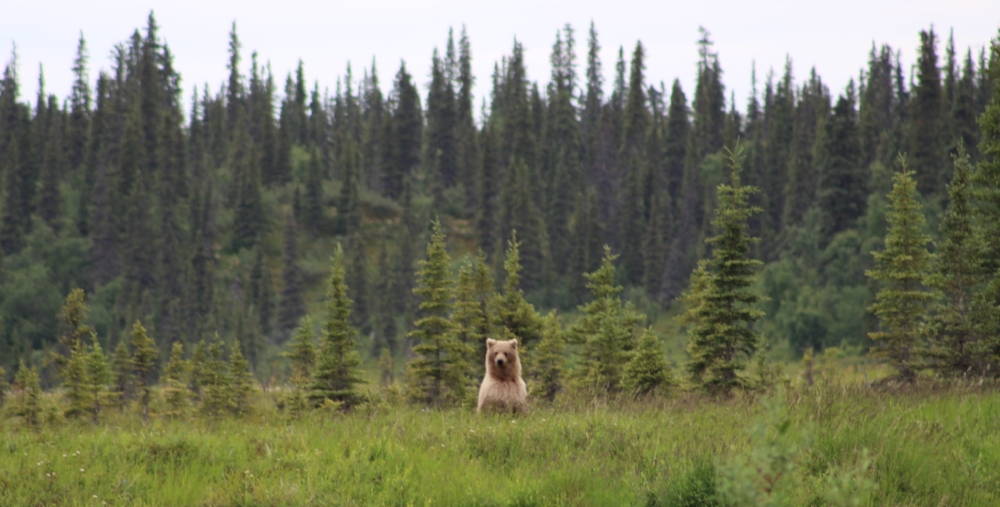
Over the course of the trip we would see over twenty grizzly bears and every one of them was focused on their lifeline – the salmon. Even skinny bear was focused on salmon, his inability to catch them left him frustrated. I had no idea this trip would display the magic of these mammals who I found to be remarkably similar to humans. Uncle Brian, who studies these bears for a living, was equally impressed with the bear show.

The main item we have in common with the bears right now is that we are both hunting for the sockeye salmon that are below the surface of the water. The sockeye look like shadows in the river. Our polarized sunglasses take the glare off the water’s surface, making visible the many shapes, sizes and shades of the rusty red, yellow and grey rocks on the river bottom. The shadows of these rocks appear to be sockeye but they do not move. Then a shadow moves upstream and with it a dozen more. They pass through an area where the ripples of the water have cleared and there, as plain as day, sockeye salmon appear like ghosts from thin air. Their eyes black, jawlines serious, bodies grey blue and the tips of their fins translucent but grey, they twitch upstream against the current. As quickly as they arrive from nowhere, they are gone. We spend so much time looking for sockeye moving upstream that I sometimes confuse the flow of the salmon and the flow of the river. Early in the trip the sockeye were hard to find but that does not last long.

Near one of our camps on day five I find a sockeye superhighway, a piece of timid mostly shallow water next to an island where over the course of five minutes I count 407 sockeye – that is 117 thousand per day, 1.6 million for a two-week run. The sockeye are no longer fun to catch, too easy, our fishing efforts have moved onto rainbow trout, which are catch and release for this river. Dead-drifting a pink puffy fly that is meant to represent salmon flesh floating downstream, I catch a huge trout that is 25 inches long. Later I catch two smaller rainbows by jiggling a fly across the surface of the water that looks like a mouse. Catching trout is much more difficult than the sockeye, while trying for more trout I notice a spot where some sockeye pass through a narrow and shallow piece of water, which makes me wonder if I can catch one by hand. I hunker down near the spot with the plan of flipping one on land when they come through. I wait but nothing comes. Freeman goes downstream to herd some towards me. The salmon have all retreated downstream, during their retreat they communicate to the others about the danger upstream and the entire flow of salmon is rerouted – not one passes by my ambush spot. Impressive creatures but they are on the menu for dinner tonight, I change my fishing set up to hook some sockeye and in short order two are fileted out.
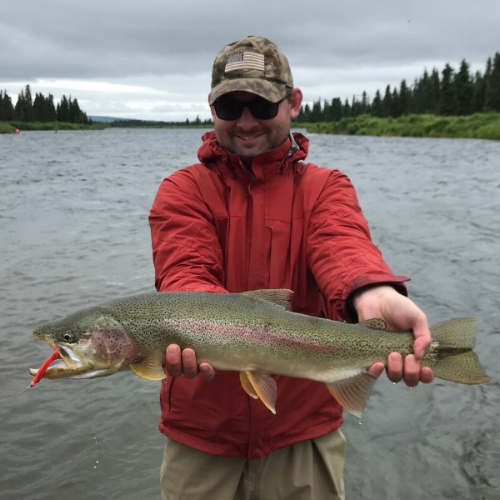
The vast size of this place continues to strike me, but the trees are so small. The largest trees are spruce, which may be over a hundred years old but are flimsy and short. Their scrubby demeanor hints at the harshness of this place when the sun is not shinning. Right now, things are good, the sun is up nearly all day, it is only kind of dark from one to four in the morning and that I am told, for the entire trip I never saw it dark but surprisingly never had an issue falling asleep. The warm temperatures sprout lush patches of white and purple wildflowers. The river is flowing and stocks an endless supply of salmon. Despite being around only seasonally their bounty enables so many living creatures to stock up for the harsh winter to come. All the animals we have seen depend on the salmon; bears, humans, eagles, fox, wolf and rainbow trout find essential caches of energy from this run. The salmon are oblivious to their role in keeping all the animals alive, all they want to do is get upstream and spawn to ensure there will be more salmon in the future. The animals too are oblivious to the significance of the salmon, they eat as many as possible without considering what would happen if they ate them all. Mother Nature has crafted a beautiful web of life in this place.

Towards the end of the trip, downstream from the mountains in the flatlands that approach the ocean, we beach the rafts on a gravel bar in the middle of the river to get out and fish. For the first time I notice the huge sky, for three hundred and sixty degrees the horizon is flat with an enormous sky, dotted with beautiful puffy white clouds. It feels as if I am poked into the sky further than I ever have been while standing on earth. Seeing the vast wild area, the abundant fresh flowing water and ideal salmon habitat makes me think about what my home, the Central Valley of California, used to be. At one time it had untamed rivers that flowed freely too, spreading out into a water world and land mix similar to where I now stand. At one time that mass of wetland was fed by miles of un-dammed rivers flowing from the Sierra and Coastal Mountains. At one time that combination delivered an abundance of salmon that was the cornerstone to a similar set of animals that continue to thrive in Alaska but are no longer in California. California will never be the fishery it used to be and despite the best intentions and restoration efforts it will never again support the web of wildlife it once had. Looking around I realize that we have ruined this exact thing before – will we learn in time to conserve this one?

This place that surrounds me is a treasure, perhaps one of the last left on earth and undoubtedly the last left in the United States. The head waters of this water are where the Pebble Mine is being pushed for, at the airfield we watched the Pebble Mine helicopters transporting materials to the mine location. It makes me sad to realize that short-sighted good wages for locals, tax revenue and profits will win and the long-term sustainability of this fishery and everything that depends on it will lose. Capitalism has some major issues and negligible punishments when an earthen dam at the mine site breaks and smothers this ecosystem with waste rock, mine tailings and whatever else is the waste water. This place and these animals are the only ones who will be punished when that happens and the odds of it happening in the next thousand years are more than likely.
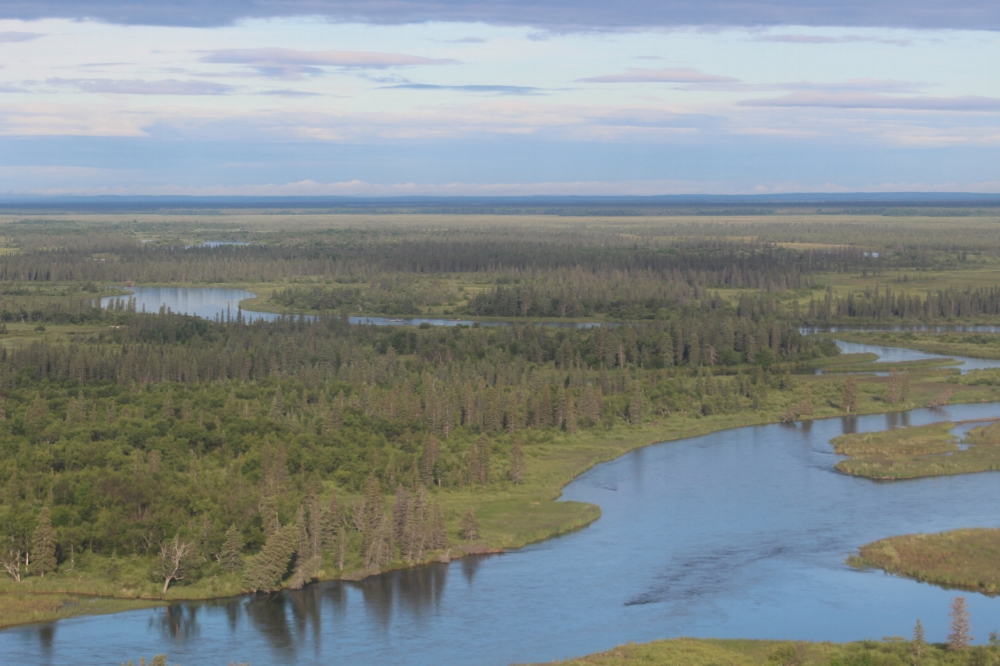
It is time to go back. The roar of the Beaver that dropped us off on the lake smoothly lands on the river. After seven days without seeing a woman I chuckle at the irony of the planes being called Beavers. It will take two trips to get everyone and the gear back, this pilot will only take three of us, despite our guides lobbying to keep the guests and their gear together. I volunteer to stay back. After the plane has left the guides grumble, “When you become a Beaver pilot they have taught you EVERYTHING, when you get that license you are never wrong.” Silly conflicts of the real world and its many personalities are back. While I wait for the next plane I try to make sense of the fact that by the end of today I will be back in the old world – it is almost incomprehensible. Soon I am in a machine flying 400 feet above the tundra, spruce, fresh water lakes and streams at 90 knots, soaking in again the vastness of this place in contrast to its scrubby trees, from a different point of view. We fly over a body of water that is so large I assume it must be part of the ocean, it is not, it is Lake Iliamna, the largest fresh water lake in Alaska. After landing on the lake we get a ride to the airport where we see some folks who look like they are on their way in. “Who won the World Cup?” we ask. They stare briefly at us, no doubt thinking about what old news that is, “France beat Croatia, 4-2.”
Our noon departure time back to Anchorage comes and goes, to catch our 4:16 PM flights home we need to be on our way to Anchorage International Airport now. After seven days of not really knowing what time it was, you would think we would have not cared about being a day late back to the real world. We do care, the thought of not getting back on time is stressful. Noah calls the flight company, as it turns out the itinerary with the noon departure was more of a guideline and we failed to let them know we had flights to catch. They were not too concerned and at the pace of life lived in these remote areas they let us know the plane would be around between 2:00 and 3:00. We have no chance at catching our flights home from Anchorage.
Sitting on the tarmac is a beautiful airplane with its door open, pilot fiddling with something in the cockpit. This was a machine that could get us to Anchorage on time. I walk over and talk to the pilot and within twenty minutes we have chartered the aircraft and are headed down the runway. The four of us spread across ten seats. I sit in the copilot spot, with a headset on I chat with the pilot over the intercom, he is from Houston and works up here only during the summer. He loves this airplane and praises its ability, he is beaming with pride to be piloting it. At an altitude of 28 thousand feet, looking down on the snow capped mountains, glaciers and live volcanoes that we flew through on the way in, I muse at the fact that the humans in this place are as seasonal as everything else. Summer is the season to make a living, winter is the season to move away or hunker down to just get by. Landing at Anchorage International Airport we are all pleased to be back to reality on schedule. My first taste of how civilized it is to travel by chartered private aircraft settles in. At the gate waiting to board the Boeing 747 home I cringe while the iPhone powers up, it pings and vibrates with messages that were not dealt with, but they do not matter. Everything is fine. The only thing I worry about is how bad I smell and if the person next to me will notice.
